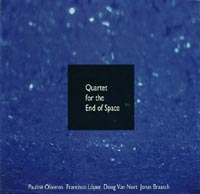|
Quartet for the End of Space
- Pauline Oliveros, Francisco López, Doug Van Nort,
Jonas Braasch
 From
the moment I click play and get into Doug Van Nort's arresting 'Outer' I just
really know that this is gonna be something quite special. Doug's piece is a
startling transportation into the stars and beyond recalling classic early electronic
music and science fiction movie soundtracks. Things start fairly calmly as I
can visualize meteors passing by, until the climax where I feel like I'm being
sucked inside out through a wormhole. Jonas' 'Web Doppelganger' give off an
eerie lost in space mood with sounds manipulated from live improvisations. Francisco's
piece as expected is very mysterious and cerebral with shifting tones, hiss,
distant gurgle and pinprick fizzing micro sounds. Again staring at the back
of my eyelids it's not difficult to imagine floating in a void, in the very
fabric of time. Pauline Oliveros' 'Mercury Retrograde' is a journey in the fluid
dynamics of liquid metal created using the EIS delay lines and modulations with
ViMic and sound geometries. The results are a fascinating listen. This just
covers half of the tracks here, the rest of which I recommend discovering for
yourselves. - Norman
Records From
the moment I click play and get into Doug Van Nort's arresting 'Outer' I just
really know that this is gonna be something quite special. Doug's piece is a
startling transportation into the stars and beyond recalling classic early electronic
music and science fiction movie soundtracks. Things start fairly calmly as I
can visualize meteors passing by, until the climax where I feel like I'm being
sucked inside out through a wormhole. Jonas' 'Web Doppelganger' give off an
eerie lost in space mood with sounds manipulated from live improvisations. Francisco's
piece as expected is very mysterious and cerebral with shifting tones, hiss,
distant gurgle and pinprick fizzing micro sounds. Again staring at the back
of my eyelids it's not difficult to imagine floating in a void, in the very
fabric of time. Pauline Oliveros' 'Mercury Retrograde' is a journey in the fluid
dynamics of liquid metal created using the EIS delay lines and modulations with
ViMic and sound geometries. The results are a fascinating listen. This just
covers half of the tracks here, the rest of which I recommend discovering for
yourselves. - Norman
Records
A stellar lineup of composers produced Quartet for the End of Space (POGUS PRODUCTIONS
21059-2): Pauline Oliveros, Jonas Braasch, Doug Van Nort, and Francisco López.
On these eight lengthy pieces they assist playing each other’s
compositions in the mode of performance which is quite close to “electroacoustic
improvisationâ€, or EAI as some will have it. This strange work
is largely characterised by very alien, unnatural sounds; great duration; slow
exploration of imaginary spaces; and certain affinities with the weather, of which
Braasch’s ‘Snow Drifts’
is the most obvious example. His ‘Web Doppelganger’
on the other hand is asking profound questions about the very nature of improvised
and aleatory music, and doing so in a very creative way. Recorded and performed
in 2010, and put together with a great sense of deliberation and care; instrumentation
is not detailed, but there is a deal of electronic music, signal processing and
computer assisted sounds blending with traditional instruments such as the saxophone.
All the musicians play with authority and gravitas on this profound and stirring
collection. - Ed Pinsent, The
Sound Projector
Into the abyss: An intense psychological experience.
Quartet for the End of Space is an all-star electroacoustic jam session
between composers and sound artists Pauline Oliveros, Francisco López,
Doug Van Nort, and Jonas Braasch. The quartet used raw material from two improvisational
sessions between February and May 2010 to construct eight compositions—two
by each composer—that blur the lines between improvisation and composition.
Together, the pieces of Quartet for the End of Space—a play off of Messiaen’s
Quartet for the End of Time—offer an intense psychological experience straight
out of Kubrick’s 2001: A Space Odyssey.
The album’s opener, “Outer,” begins with low-end engine-like
rumblings that swell to an ambient, spacious composition. In the last quarter
of the piece, extraterrestrial insect-like sounds swarm between the speakers
as the sonic texture is gradually engulfed in a tide of white noise.
“Web Doppelganger” is a tour through a spaceship, with manipulated
saxophones mumbling like androids before a backdrop of ever-evolving celestial
drones. “Mercury Retrograde” features free-jazz horn squealing over
reversed tape, struck strings and mallet percussion. In “Snow Drifts,”
alien howling sounds are layered into a microtonal field of pulsing sonic interferences.
“Cyber Talk” is the sound of a malfunctioning robot: digital beeps,
metallic scrapes, and inhuman slurping sounds spiral around one another in schizophrenic
spurts.
Perhaps most intriguing about Quartet for the End of Space is its cohesive
narrative arc. While each piece clearly has it’s own sonic character, there’s
a conceptual and textural continuity between the works that constructs a compelling
and psychologically charged whole. The pieces are arranged so as to lead a virtual
tour through a futuristic environment. The journey begins outside of a spaceship,
and then proceeds through its inner chambers, some of which are chillingly sedate
(“Untitled #273”), while others offer disorienting and dystopian visions
of the future (“Cyber Talk”).
By the time the album’s last bits of static fade out, Quartet for the
End of Space has guided you on a chilling Sci-Fi journey. The album closes
with its most ambient composition, “Untitled #273.” Floating weightlessly
over sustained synth-like chords, breathing sounds, and quiet bass rumblings,
the piece seems to offer an exterior shot of a ship disappearing into the abyss
of space. - Hannis Brown, Tokafi
|



